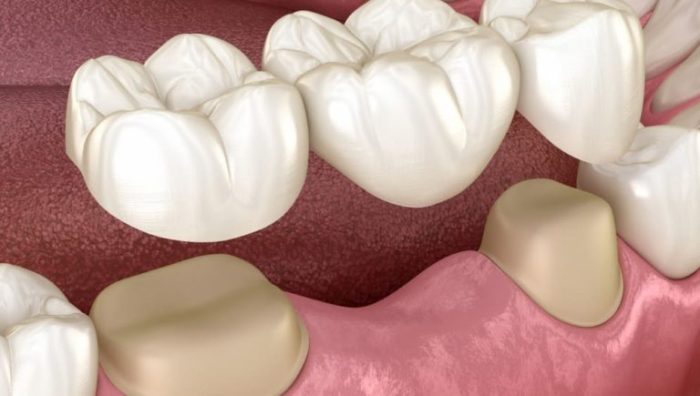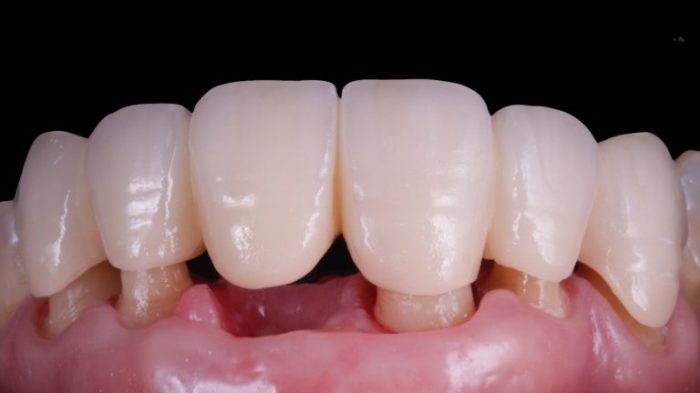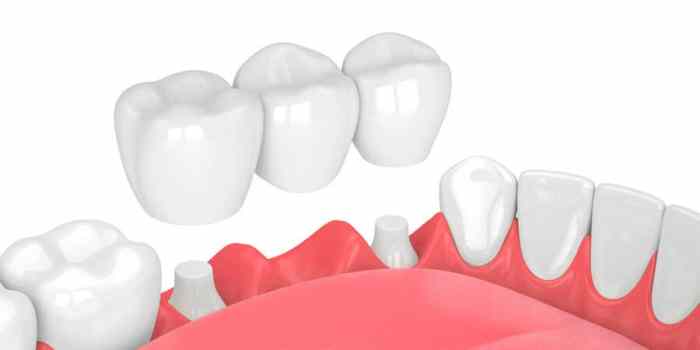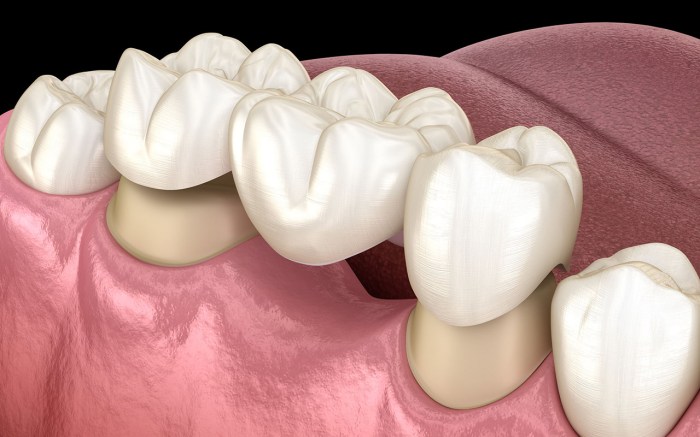Prótesis fija de 3 unidades – Las prótesis fijas de 3 unidades, también conocidas como puentes dentales, ofrecen una solución innovadora y efectiva para restaurar la funcionalidad y estética de tu sonrisa. Compuestas por tres coronas unidas, estas prótesis brindan soporte y estabilidad excepcionales, devolviéndote la confianza para sonreír ampliamente.
Desde sus ventajas y desventajas hasta los procedimientos clínicos y el mantenimiento, profundizaremos en el mundo de las prótesis fijas de 3 unidades, explorando sus aplicaciones, beneficios y todo lo que necesitas saber para tomar una decisión informada sobre tu salud bucal.
Fixed Prosthesis of 3 Units

A fixed prosthesis of 3 units is a dental restoration that replaces missing teeth and is permanently attached to the adjacent teeth. It is typically used when one or more teeth are missing and the surrounding teeth are healthy and strong enough to support the prosthesis.
Prótesis fija de 3 unidades son una excelente opción para restaurar la función y estética de los dientes perdidos. Para obtener más información sobre las implicaciones ocultas en los crucigramas, como “carry a torch for”, visita carry a torch for crossword . Además, las prótesis fija de 3 unidades ofrecen una solución duradera y cómoda que puede mejorar significativamente la calidad de vida.
The prosthesis consists of three components: two crowns that fit over the adjacent teeth and a pontic that replaces the missing tooth. The crowns are usually made of metal or porcelain, while the pontic can be made of various materials, including porcelain, acrylic, or metal.
Applications in Dentistry
Fixed prostheses of 3 units are commonly used in dentistry to:
- Replace missing teeth and restore the patient’s smile.
- Improve the patient’s ability to chew and speak.
- Prevent the adjacent teeth from shifting out of position.
- Maintain the health of the gums and bone tissue.
Advantages and Disadvantages: Prótesis Fija De 3 Unidades

Fixed prostheses of 3 units offer several advantages, including:
- Improved aesthetics:They restore the natural appearance of the teeth, enhancing the patient’s smile.
- Enhanced function:They allow for proper chewing and speech, improving overall oral function.
- Durability:Fixed prostheses are typically made of strong materials that can withstand the forces of chewing and biting.
- Long-term solution:With proper care, fixed prostheses can last for many years, providing a long-term solution for missing teeth.
However, there are also some potential drawbacks associated with fixed prostheses of 3 units:
- Irreversibility:Once placed, fixed prostheses cannot be easily removed. This means that if the patient’s needs change in the future, it may be difficult to make adjustments.
- Cost:Fixed prostheses can be expensive to fabricate and place.
- Preparation of adjacent teeth:To accommodate the prosthesis, the adjacent teeth need to be prepared, which involves removing some of their natural structure.
- Potential for complications:As with any dental procedure, there is a risk of complications, such as infection or damage to the adjacent teeth.
When considering fixed prostheses of 3 units, it is important to weigh the advantages and disadvantages carefully to determine if they are the best option for the individual patient.
Compared to other dental restoration options, fixed prostheses of 3 units offer several advantages:
- They are more durable than removable dentures.
- They provide better aesthetics than dental implants.
- They are less expensive than dental implants.
However, fixed prostheses of 3 units are also less versatile than removable dentures and dental implants.
Design and Fabrication

Creating a fixed prosthesis of 3 units involves meticulous design and fabrication processes that adhere to specific principles and considerations. The design must prioritize functionality, aesthetics, and long-term durability, while the fabrication process entails selecting appropriate materials and employing precise techniques.
Design Principles
The design of a fixed prosthesis of 3 units centers around ensuring proper occlusion, maintaining the health of the abutment teeth, and achieving an aesthetically pleasing result. The prosthesis should distribute occlusal forces evenly to prevent overloading any single abutment and promote longevity.
The design also considers the patient’s facial features and smile line to ensure a natural and harmonious appearance.
Materials Selection
The materials used in the fabrication of a fixed prosthesis of 3 units significantly impact its strength, durability, and biocompatibility. Common materials include:
- Metal alloys:Durable and strong, suitable for frameworks and connectors.
- Porcelain:Aesthetically pleasing, but more brittle and requires careful handling.
- Zirconia:Strong, biocompatible, and aesthetically versatile, often used for both frameworks and crowns.
Fabrication Techniques, Prótesis fija de 3 unidades
The fabrication process involves several key steps:
- Impression taking:Accurate impressions of the teeth and surrounding tissues are taken to create a working model.
- Waxing:A wax pattern is created on the working model to represent the desired prosthesis.
- Casting:The wax pattern is invested in a mold and molten metal is poured to create the metal framework.
- Soldering:The framework is joined to the porcelain or zirconia crowns using a soldering technique.
- Finishing:The prosthesis is polished and glazed to achieve a smooth surface and desired aesthetics.
Digital Technologies
Digital technologies are increasingly used in the design and production of fixed prostheses. Computer-aided design (CAD) software allows for precise design and customization, while computer-aided manufacturing (CAM) systems automate the fabrication process, resulting in greater accuracy and efficiency.
Clinical Procedures

The clinical procedures involved in placing a fixed prosthesis of 3 units encompass a series of meticulous steps, from tooth preparation to impression taking and cementation. Each step plays a crucial role in ensuring the prosthesis’s longevity, functionality, and aesthetic integration.
Tooth Preparation
Tooth preparation involves reshaping the abutment teeth to create space for the prosthesis and ensure proper retention. This is achieved using rotary instruments under local anesthesia. The amount of tooth structure removed depends on the design of the prosthesis and the existing tooth morphology.
Impression Taking
After tooth preparation, impressions are taken to capture the precise contours of the prepared teeth and the surrounding tissues. This is essential for fabricating a prosthesis that fits accurately and adapts to the patient’s unique anatomy.
Cementation Techniques
The final step is cementation, where the prosthesis is permanently attached to the abutment teeth using dental cement. The cementation technique is critical to ensure a strong bond between the prosthesis and the teeth, preventing dislodgement and ensuring long-term stability.
Maintenance and Care

Regular maintenance and proper care are vital for the longevity and optimal function of a fixed prosthesis of 3 units. Adhering to these guidelines ensures the prosthesis’s durability, patient comfort, and overall dental health.
Patients play a crucial role in maintaining their prosthesis by practicing good oral hygiene, attending regular check-ups, and addressing potential issues promptly.
Regular Check-ups
Regular check-ups with a dentist or dental hygienist are essential to monitor the prosthesis’s condition, assess its fit and stability, and identify any potential problems early on.
- During check-ups, the dentist will examine the prosthesis for any signs of damage, wear, or loosening.
- They will also check the surrounding teeth and gums for any signs of inflammation or infection.
- Regular check-ups allow for timely interventions, such as adjustments, repairs, or professional cleanings, to maintain the prosthesis’s health and longevity.
Hygiene Practices
Maintaining good oral hygiene is paramount for the longevity of a fixed prosthesis and the overall health of the teeth and gums.
- Brushing twice a day with a soft-bristled toothbrush and fluoride toothpaste is essential to remove plaque and bacteria.
- Flossing daily helps clean the areas between the teeth and under the prosthesis, where a toothbrush cannot reach.
- Using an interdental brush or water flosser can further enhance cleaning effectiveness.
- Regular use of an antibacterial mouthwash can help reduce bacteria and maintain fresh breath.
Potential Repair Procedures
Despite proper maintenance, a fixed prosthesis may occasionally require repair due to factors such as wear, damage, or changes in the patient’s oral anatomy.
- Minor repairs, such as adjusting the fit or replacing a loose screw, can often be done during a regular check-up.
- More extensive repairs, such as replacing a broken crown or repairing a damaged framework, may require additional appointments.
- Prompt attention to any potential issues can prevent further damage and maintain the prosthesis’s functionality and aesthetics.
FAQ Compilation
¿Cuánto duran las prótesis fijas de 3 unidades?
Con el cuidado adecuado, las prótesis fijas de 3 unidades pueden durar entre 5 y 15 años o incluso más.
¿Son dolorosas las prótesis fijas de 3 unidades?
El proceso de colocación de una prótesis fija de 3 unidades generalmente no es doloroso. Se administra anestesia local para garantizar la comodidad del paciente.
¿Las prótesis fijas de 3 unidades afectan el habla o la masticación?
Una vez que te hayas acostumbrado a la prótesis, no debería afectar significativamente tu habla o masticación.
